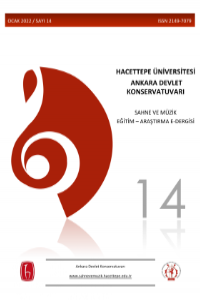ORKESTRA ŞEFLİĞİ VE BRAHMS SENFONİLERİNİN YORUMUNDA STİL
Bu araştırmada, Brahms'ın Senfoni'lerinin önemli şefler tarafından yönetilmesi ve yorumları ele alınmıştır. Yorumların bestecinin isteğine uygun olabilmesi için hangi unsurların dikkate alınması gerektiği irdelenmiştir. Tarih boyunca Brahms senfonileriyle ilgili dökümanlar taranarak verilere ulaşılmıştır. Bu veriler Brahms uzmanı kaynakların görüşleri dikkate alınarak değerlendirilip yorumlanmıştır. Buna göre, Brahms'ın aslında Klasik geleneklere göre bestelediği senfonilerin bir çok önemli şef tarafından Romantik abartılarla yorumlandığı saptanmıştır. Brahms senfonilerinin nasıl yorumlanması gerektiği hem bestecinin kendi, hem de konunun uzmanlarının yazdığı kaynaklarda belirtilmiştir. Sonuç olarak Brahms'ın senfonileri seslendirilirken, ortaya çıkacak yorumun, tarihsel gerçeklere bağlı kalarak ve bestecinin istekleri göz önünde bulundurularak yapılması önerilmektedir.
Anahtar Kelimeler:
Johannes Brahms, Senfoni, Orkestra Şefliği
ORCHESTRAL CONDUCTING AND STYLE IN THE INTERPRETATION OF BRAHMS SYMPHONIES
In this research, Brahms symphonies and their interpretation by important conductors is investigated. Which elements are required in order to achieve an interpretations for composer's will is also examined. The data is collected from the historical treatises written about Brahms symphonies. The data is evaluated and interpreted by paying attention to the opinions of Brahms specialists. Suggestions about the interpretation of Brahms symphonies is stated in the letters of Brahms himself and treatises of Brahms specialists. As conclusion; it is recommended that the interpretations of Brahms symphonies should depend on the historical facts and the Composer's will.
Keywords:
Johannes Brahms, Symphony, Orchestral Conducting,
___
- Bairstow, E. (1937). “Brahms's Fourth Symphony, Op. 98.”. The Musical Times , 78 (1129), 220-224 Bowen, J. A. (2008). The Cambridge Companion to Conducting. New York: Cambridge University Press. Brown, J. (1996). Johannes Brahms, An Essential Guide To His Life and Works. London: Pavilion Books Ltd.
- Burkholder, J. P. (1984). Brahms and Twentieth-Century Classical Music. 19th-Century Music , 8, 75–83.
- Deas, J. (1933). The Symphonies of Brahms. Music & Letters , 14 (2), 112-116. Dyment, C. (2016). Conducting The Brahms Symphonies, From Brahms To Boult. Woodbridge: The Boydell Press. Frisch, W. (2003). Brahms: The Four Symphonies . New Haven & London: Yale University Press. Lee, E. M. (1916). The Story of Symphony. London: The Walter Scott Publishing Co. Ltd. Musgrave, M. (1983). Brahms's First Symphony: Thematic Coherence and Its Secret Origin. Music Analysis , 2 (2), 117-133. Meyers, R. (2015). Western Classical Music From 1600 to 1899. New York: Lulu Press, Inc. Schoenberg, A. (1975). Brahms The Progressive. A. Schoenberg içinde, Style and Idea (s. 398-441). London: Faber & Faber. Schuller, G. (1998). The Compleat Conductor. New York: Oxford University Press Steen, M. (2003). Brahms The Great Composers. London: Icon Books. Ravetz, E. (2002). Earl Wild - Brahms. Ohio: Ivory Classics. Vural, T. (2012). Ludwig van Beethoven'ın Op 21, 1 Numaralı Senfonisi'nin Orkestra Şefliği Tekniği Açısından İncelenmesi. e-Journal of New World Sciences Academy , 7 (3), 307-317. Watson, S. R. (1947). The Romantic Brahms. The Phi Beta Kappa Society , 17 (1), 69-78. Young, J. B. (2017). Brahms A Listener's Guide. New York: Dover Publications.
- Başlangıç: 2015
- Yayıncı: Hacettepe Üniversitesi
